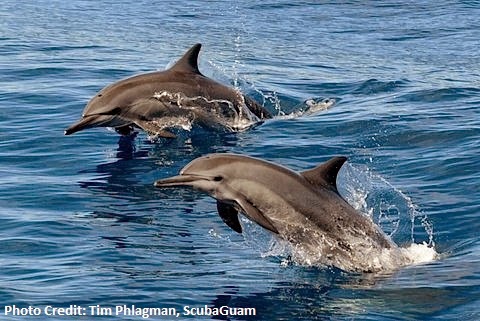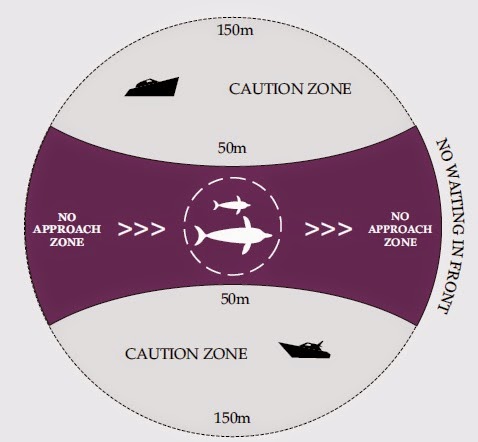Unknown to most, the Maldives is actually one of the best places in the world to come whale and dolphin watching, with 23 different species of Cetacean (the scientific Order containing dolphins, porpoises, and whales). That’s more than a quarter of the Worlds species! The deep channels between atolls are used as a ‘whale highway’ during migrations from breeding to feeding grounds for many oceanic whale species, and Maldives is even home to the largest animal on our planet, the Blue Whale (Balaenoptera musculus)! These deep channels are only really accessible to safari vessels, so here at the resort we focus in the smaller, but no less spectacular, shoreline associated species; the most common of which is our Spinner Dolphin (Stenella longirostris).
 |
| A small species of dolphin at only 2.2m, Spinners have a long nose and a light grey racing stripe |
Characterized by a long beak or rostrum (their name in Latin literally means “long nose”) with a light grey stripe down the side of their body, Spinners are famous for their incredible acrobatic behaviour. The Spinners leap from the water and rotate on a longitudinal axis. The record number of spins is 7 in 1 jump, and it is this behaviour that leaves our guests in awe of the dolphins’ aerobatic beauty and strength. Through years of observation, the Maldivian people have recognized patterns in the dolphins’ daily behaviour and can predict where the dolphins will be, depending on the time of day, which is what has made dolphin watching cruises throughout Maldives so successful. We can almost guarantee Spinner Dolphin sightings on a daily basis. As scientists, we have studied these bahavioural cycles closely and though our careful observations we know exactly what the dolphins are doing and why. So what have we found out?
Let’s take a look at a day in the life of a Maldivian Spinner Dolphin:
As the sun begins to set and darkness falls, one of the World’s most impressive migrations begins: plankton begins to rise from the abyssal depths of 2000m to around 200m. This diurnal vertical migration brings with it mesopelagic fish and squid from the depths which feast on the plankton. It’s at this time, when these riches come within reach, that the dolphins split into small groups called sub-units and begin to hunt. Spinners can dive to depths of around 300m and hold their breath for approximately 10 minutes, whilst communicating with the rest of the pod using high frequency whistles. Using echolocation, the dolphins can scan the darkness and create a mental image of their surroundings using sound. Dawn is a time for play as the dolphin sub-units reunite in the channels between the islands and head inside the shallow atoll to rest in safety. Breathing becomes synchronized and more frequent as the dolphins drift into a state of sleep. As conscious breathers, dolphins cannot go to sleep completely as they would drown, so they exhibit something called uni-hemispherical sleep, which is where one side of the brain is shut down whilst the other half is awake, watching for predators such as sharks and regulating breathing. During the day they alternate the sleeping side of their brain and wake up refreshed in the evening, ready for the nights hunt.
The resorts have harnessed this in-depth knowledge of dolphin behavioural ecology to combine our dolphin cruise with the sunset, as the dolphins are most active at this time and we can predict their presence just outside the atoll. Many dolphin criuses will operate at the same time of day due to these reasons, and therefore create a disturbance to the dolphin populations. Boat disturbance is now thought to be the biggest threat to dolphin populations in Maldives. Too much boat interference can cause disruption of natural breathing and feeding cycles, whilst irresponsible and reckless boat movement can cause panic induced stress, separation of mothers and calves, and even death by collisions.
 |
| Code Of Conduct |
Due to these threats and our intricate knowledge of their immense intelligence and complex ecology, a code of conduct was developed. This set of rules was developed by the resident marine biologist at Six Senses Laamu Resort, and we at Gili have also put it in place for our boat crews to follow so that we can minimize our disturbance to the local Spinner population. All of our boat captains and crew have under gone training so they not only know the code of conduct and how to effectively implement it, but they also have an in-depth knowledge of dolphin biology and behavioural ecology which helps in understanding why we implement these rules. The code includes not going too fast when in the dolphins vicinity, and not rapidly changing speed and direction so as to reduce chance of collision and reduce engine noise and vibration. Not approaching directly from in front or behind the pod and converging onto prevents the feeling of being chased, gives dolphins the choice of coming to bow-ride, but instead converging onto their direction of travel, allowing the dolphins the choice of whether or not to come to us, avoiding chasing and splitting the pod. The more resorts who take this code of conduct on board, the more effective our efforts will be to safeguard the dolphin watching industry for future generations!
 |
| A juvenile Spinner Dolphin entertains guests whilst a pod of 50 surrounds the boat! |
Alongside this eco-friendly initiative, one of our resident marine biologists is present on the cruise 4 times per week, offering a short presentation explaining a little about the life of the dolphins and why we input our code of conduct. So far, this has been received extremely well by the guests who relish the opportunity to ask the marine biologist questions about these beautiful animals whilst they sip champagne and observe incredible acrobatics on an eco-friendly cruise.